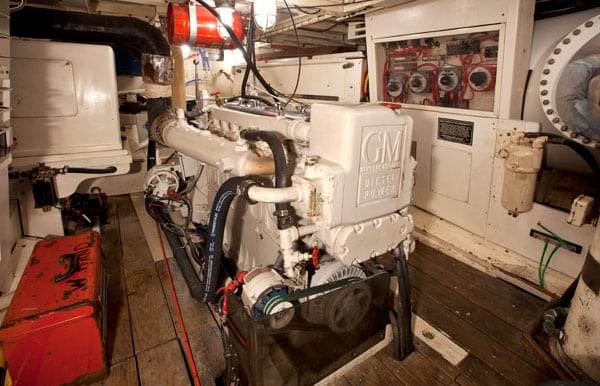
6-71
When I was a kid, I loved to sit in the back of the bus and listen to the supercharger whine as the Detroit Diesel 6-71 spun to what seemed like impossibly high rpm. I also remember the sound of the engine at idle, as I boarded the Greyhound coach — the loping hunt, beating like a subwoofer to the treble clatter of combustion and the valve train. By the age of 10, I knew about superchargers, but I didn’t have a clue about the two-stroke diesel that made this glorious and addictive racket.
Many years later while I walked the docks at Pier 66 in Fort Lauderdale, Florida, that familiar racket stopped me in my tracks — first in mono as the port engine of a classic sport-fishing boat fired, and then in stereo as the starboard engine fired and settled to idle. I wanted those engines in my fantasy boat. Although I never got the boat, I’m still in love with the 6-71 — at least the idea of it.
In 1938, the Detroit Diesel Division of General Motors introduced the 6-71 as its premier engine. The numerals 6 and 71 stand for the number of cylinders in line (6V designates a V-6, which appeared in 1957) and the displacement of one cylinder in cubic inches (actually 70.93 cubic inches). Every engine in the 71 series had a bore of 4.25 inches and a stroke of 5.0 inches. Tuned for commercial duty, it produced 165 horsepower. The battle-rated version made for the U.S. Navy developed 225 horsepower. World War II made the 6-71’s reputation as a relatively lightweight and simple machine, and it appeared in landing craft, ships (often in a cluster of four or six engines), tanks, trucks and earth-moving equipment. Stan Grayson in his book Engines Afloat (www.devereuxbooks.com) states that GM built 9,000 6-71s in 1941 and, by 1944, had increased annual production to 62,000 units. That figure does not include the engines made for Gray Marine. The grand total for the war years was about 100,000 engines.
The 6-71 makes a unique sound because it’s a two-stroke diesel. Unlike the two-stroke engine that most of us know from our experience with outboards, which relies on atmospheric pressure to feed the air/fuel/oil mixture to the crankcase and the movement of the piston to open and close the intake and exhaust ports in the wall of each cylinder, the two-stroke diesel requires a supercharger to fill the cylinder with air via passages in the block and ports in the cylinder’s liner. Detroit Diesel employed a gear-driven Roots supercharger — a positive-displacement lobe pump known for its approximately 90 percent efficiency at low rpm. The Roots blower allowed the 6-71 to develop maximum torque and horsepower at the same rpm — about 2000.
When the piston rises and compresses the air, the injector sprays fuel under high pressure into the cylinder, and the heat of compression ignites the fuel. Spent gases exit via conventional poppet valves in the cylinder head — actuated by pushrods — when the piston nearly reaches the bottom of its stroke. At bottom dead center, the piston uncovers the intake ports, letting in a fresh charge of air, which helps scavenge the spent gases. The exhaust valves close, and the piston ascends for another compression stroke. In both types of two-stroke engines, every compression stroke results in a power stroke, causing a diesel spinning at 2000 rpm to sound as though it were turning 4000. Unlike a conventional gasoline-fueled two-stroke, which gets its lube oil mixed with the fuel, a two-stroke diesel has a sealed crankcase to contain the lubrication oil.
Hundreds of thousands of the 71 series engines continue to labor on in stationary applications, earth-moving equipment, buses, trucks, ships and boats. Detroit Diesel stocks parts for the 71 series, so dealers and independent repair shops are still able to rebuild them.









